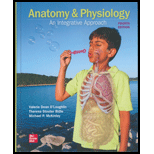
Anatomy & Physiology: An Integrative Approach
4th Edition
ISBN: 9781264265435
Author: Michael McKinley
Publisher: Mcgraw-hill Higher Education (us)
expand_more
expand_more
format_list_bulleted
Concept explainers
Question
Chapter 1, Problem 10DYKB
Summary Introduction
Introduction:
The control system of homeostasis is separated into two categories based on whether the system amplifies the stimulus in the same direction or it maintains the variable in normal range in the opposite direction. The two types of feedback control include positive feedback and negative feedback respectively.
Expert Solution & Answer
Want to see the full answer?
Check out a sample textbook solution
Students have asked these similar questions
The Sentinel Cell: Nature’s Answer to Cancer?
Molecular Biology Question
You are working to characterize a novel protein in mice. Analysis shows that high levels of the primary transcript that codes for this protein are found in tissue from the brain, muscle, liver, and pancreas. However, an antibody that recognizes the C-terminal portion of the protein indicates that the protein is present in brain, muscle, and liver, but not in the pancreas. What is the most likely explanation for this result?
Molecular Biology
Explain/discuss how “slow stop” and “quick/fast stop” mutants wereused to identify different protein involved in DNA replication in E. coli.
Chapter 1 Solutions
Anatomy & Physiology: An Integrative Approach
Ch. 1.1 - What is the relationship between anatomy and...Ch. 1.1 - How might knowledge of surface anatomy be...Ch. 1.1 - Which field of physiology examines how the heart,...Ch. 1.2 - Compare and contrast how anatomists and...Ch. 1.4 - Prob. 6WDYLCh. 1.4 - Prob. 8WDYLCh. 1.5 - Prob. 9WDYLCh. 1.5 - Prob. 10WDYLCh. 1.5 - Prob. 12WDYLCh. 1.5 - Prob. 13WDYL
Ch. 1.6 - List and describe the three components of a...Ch. 1.6 - Prob. 15WDYLCh. 1.6 - Prob. 16WDYLCh. 1.7 - Prob. 17WDYLCh. 1 - Which field of anatomy examines the superficial...Ch. 1 - Prob. 2DYKBCh. 1 - Prob. 3DYKBCh. 1 - Prob. 4DYKBCh. 1 - Prob. 5DYKBCh. 1 - Prob. 6DYKBCh. 1 - Which body cavity is located inferior to the...Ch. 1 - Prob. 8DYKBCh. 1 - Prob. 9DYKBCh. 1 - Prob. 10DYKBCh. 1 - What are the similarities and differences between...Ch. 1 - List the levels of organization in a human,...Ch. 1 - Prob. 13DYKBCh. 1 - Name the organ systems in the human body.Ch. 1 - Describe the body in the anatomic position. Why is...Ch. 1 - List the anatomic term that describes each of the...Ch. 1 - What are the two body cavities within the...Ch. 1 - Describe the structure and function of serous...Ch. 1 - What are the main components in a homeostatic...Ch. 1 - Prob. 20DYKBCh. 1 - Your friend Eric complains of some pain in his...Ch. 1 - Your friend Eric complains of some pain in his...Ch. 1 - Your friend Eric complains of some pain in his...Ch. 1 - When you are outside on a hot, humid day, what...Ch. 1 - A friend just started taking Zoloft (an SSRI) and...Ch. 1 - Lynn was knocked off her bicycle during a race....Ch. 1 - Prob. 2CSLCh. 1 - Prob. 3CSL
Knowledge Booster
Learn more about
Need a deep-dive on the concept behind this application? Look no further. Learn more about this topic, biology and related others by exploring similar questions and additional content below.Similar questions
- Molecular Biology Question A gene that codes for a protein was removed from a eukaryotic cell and inserted into a prokaryotic cell. Although the gene was successfully transcribed and translated, it produced a different protein than it produced in the eukaryotic cell. What is the most likely explanation?arrow_forwardMolecular Biology LIST three characteristics of origins of replicationarrow_forwardMolecular Biology Question Please help. Thank you For E coli DNA polymerase III, give the structure and function of the b-clamp sub-complex. Describe how the structure of this sub-complex is important for it’s function.arrow_forward
- Molecular Biology LIST three characteristics of DNA Polymerasesarrow_forwardMolecular Biology RNA polymerase core enzyme structure contains what subunits? To form holo enzyme, sigma factor is added to core. What is the name of the structure formed? Give the detailed structure of sigma factor and the function of eachdomain. Please help. Thank youarrow_forwardMolecular Biology You have a single bacterial cell whose DNA is labelled with radioactiveC14. After 5 rounds of cell division, how may cells will contain radioactive DNA? Please help. Thank youarrow_forward
- 1. Explain the structure and properties of atoms and chemical bonds (especially how they relate to DNA and proteins). Also add some pictures.arrow_forward1. In the Sentinel Cell DNA integrity is preserved through nanoscopic helicase-coordinated repair, while lipids in the membrane are fortified to resist environmental mutagens. also provide pictures for this question.arrow_forwardExplain the structure and properties of atoms and chemical bonds (especially how they relate to DNA and proteins). Also add some pictures.arrow_forward
- In the Sentinel Cell DNA integrity is preserved through nanoscopic helicase-coordinated repair, while lipids in the membrane are fortified to resist environmental mutagens. also provide pictures for this question.arrow_forward1. Explain how genetic information is stored, copied, transferred, and expressed. Also add some pictures for this question.arrow_forward!. Describe biological macromolecules (DNA, RNA, proteins, lipids, etc.) and how they function in the cell. also provide some images for this question.arrow_forward
arrow_back_ios
SEE MORE QUESTIONS
arrow_forward_ios
Recommended textbooks for you
 Comprehensive Medical Assisting: Administrative a...NursingISBN:9781305964792Author:Wilburta Q. Lindh, Carol D. Tamparo, Barbara M. Dahl, Julie Morris, Cindy CorreaPublisher:Cengage Learning
Comprehensive Medical Assisting: Administrative a...NursingISBN:9781305964792Author:Wilburta Q. Lindh, Carol D. Tamparo, Barbara M. Dahl, Julie Morris, Cindy CorreaPublisher:Cengage Learning Biology: The Dynamic Science (MindTap Course List)BiologyISBN:9781305389892Author:Peter J. Russell, Paul E. Hertz, Beverly McMillanPublisher:Cengage Learning
Biology: The Dynamic Science (MindTap Course List)BiologyISBN:9781305389892Author:Peter J. Russell, Paul E. Hertz, Beverly McMillanPublisher:Cengage Learning





Comprehensive Medical Assisting: Administrative a...
Nursing
ISBN:9781305964792
Author:Wilburta Q. Lindh, Carol D. Tamparo, Barbara M. Dahl, Julie Morris, Cindy Correa
Publisher:Cengage Learning

Biology: The Dynamic Science (MindTap Course List)
Biology
ISBN:9781305389892
Author:Peter J. Russell, Paul E. Hertz, Beverly McMillan
Publisher:Cengage Learning